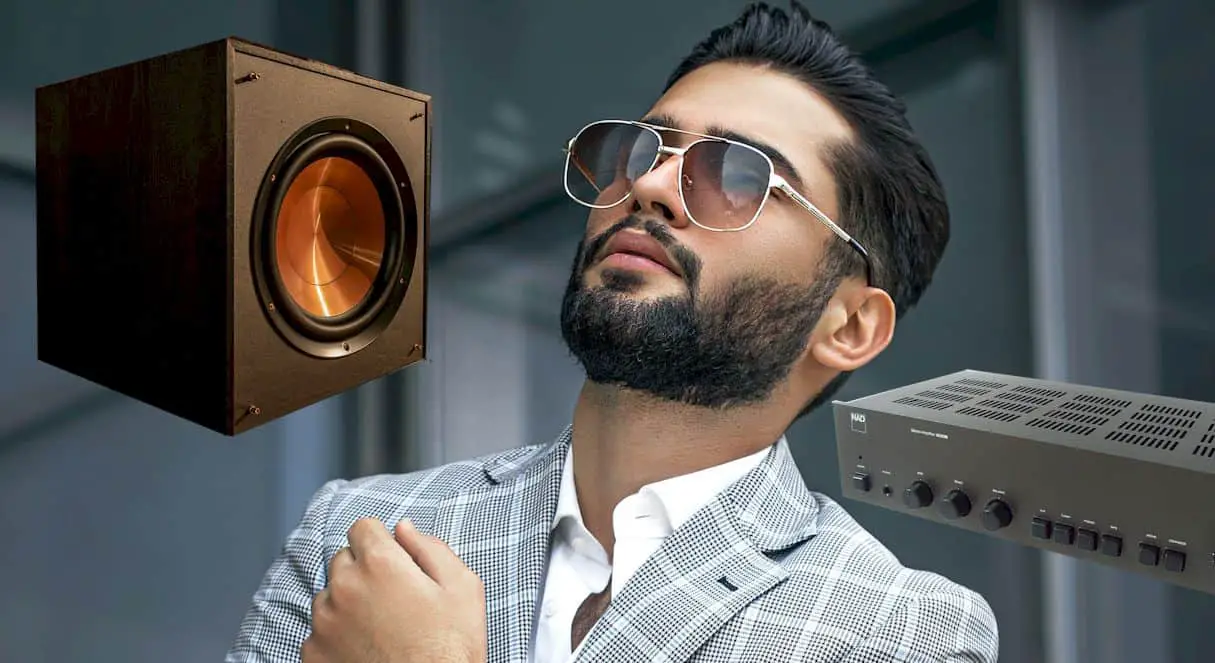As an ardent lover of music, you're pretty much particular about the quality of your audio devices. You know you want to enjoy the detailed low-end bass just as much as you want to hear the detailed mid and high notes.
As a result, to solve your audio device’s low-end bass problem, you hit the market to get yourself a great subwoofer. We all know that your vintage home audio system alone isn’t enough to give you that low-end bass satisfaction that you need.
But since your subwoofer order arrived, you've racked your brains to figure how to connect a subwoofer to an old amplifier. At least, if you have a vintage home audio system set up, you’re most likely desperately searching for answers to the above question.
The reason? Connecting your new subwoofer to your old amplifier would boost the sound quality of your vintage audio system while saving you money. But of course, you know that already. Otherwise, you won’t be trying to connect your subwoofer to your old amplifier.
Anyway, in the Spirit of a better-sounding vintage home audio system, we present a straightforward guide that'll help you easily connect your subwoofer to your vintage amplifier. Ready? Let's get into it already.
Related: How to connect subwoofer to receiver without subwoofer output
Contents
About the Stereo Subwoofer
Subwoofers are the real MVPs (Most Valuable Player) for producing the deep bass and sub-bass sounds. The truth is, you can’t rely on your regular and surround sound systems to spice up your home audio system with that deep bass and sub-bass sound that echoes deep in your chest as your favorite music fills the atmosphere.
Sure, you can think your regular speakers produce the deep bass sound you've always wanted. But I tell you, my friend, you've not experienced how authentic deep bass and sub-bass sounds feel like until you try a subwoofer. You'll hear a different level of deep bass and sub-bass that you could never have imagined existed, and you'll enjoy every bit of it with a great subwoofer.
You know you've got real deep bass and sub-bass sound when your glass of water sitting pretty on the table ripples, or you feel the vibration deep down your lungs, spine, and every other core part of your body.
Now, that's the bass sound level you'll get (definitely more) with a subwoofer. The good news is, they are part of an audio system makeup. Hence, you can connect it to your amplifier and sound system when you get a great subwoofer.
Related: Mounting Amp to Sub Box in Your Car
The function of a Subwoofer
Here, we’ll tie the function and benefits of a good subwoofer together so you can have a level of understanding of how it works.
- Produces High-quality Deep Bass: One of the significant and apparent functions of the subwoofer is to produce deep bass and sub-bass sounds. Generally, these sounds are known as lower frequency sounds. Now, the question is, can't your regular speakers produce low-frequency sounds? Well, yes, it can.
However, as earlier explained, the lower frequency sounds that your regular speakers would produce won’t come close to what a subwoofer can produce. The truth is, your regular speaker can only produce frequencies as low as 50Hz. While that isn't, 50Hz is not low enough to send deep vibrations down your spine.
But subwoofers produce frequencies as low as 20Hz or lower. With these low-frequency numbers, you should be able to picture how deep the sound produced by a subwoofer is.
Think about your subwoofer as that bass singer in a choir whose bass and sub-bass have an unimaginable depth that you've probably never felt before. Trust me, and it naturally helps you appreciate the very low-frequency sounds and their value to our music experience.
- Reduces Distortion: You see, making a regular speaker produce very low frequencies is like trying to force a fish to fly. While many Disney cartoons have tried to prove to us that fishes can jump so high out of the water, but they quickly dive back in, that doesn't mean they can fly.
Now, my point is, regular speakers are good. But when they are used to produce low-frequency sounds at increased volumes, you’d start to hear distortions caused by the speaker’s diaphragm. On the flip side, a great subwoofer allows you to play low frequencies at an increased volume without distortions.
- Division of Labor: Even full-range speakers won’t function to your satisfaction without proper division of labor. If you own a full-range speaker, you most likely burden the smaller speakers with the task of producing low-frequency sounds. In all honesty, that's not good enough.
And if the speaker could talk, it’d probably nag about how you’re traumatizing it by making it produce low frequencies that are beyond its power. Rather than overburden your full-range speaker with the task of producing low-frequency sounds, it would help if you introduced a great subwoofer to the speaker set. It would lighten the burden of the smaller speakers so they can perform their original duty well.
Types of Subwoofers
Generally, subwoofers come in two types. They are the Passive Subwoofers and the Active Subwoofers. Although there are many subwoofer styles, such as bandpass, etc., They all fall into active or passive subwoofers.
- Passive Subwoofers: This type of subwoofers does not have a built-in amplifier, power source, or receiver. Instead, they rely on external power sources and amplifiers to produce the deep bass and sub-bass that you love.
You'll get your money's worth from a passive subwoofer when you use it in a spacious room. That's why home theatre designers use them when setting up home theatres. Newbies might find it a bit complicated because you need all these extras like a power source, amplifiers, etc., to set up a passive subwoofer.
- Active Subwoofers: On the other hand, active subwoofers are like independent people who can take care of themselves. It comes with a power source and a built-in amplifier. Perhaps that's why it's also referred to as a powered subwoofer.
If you’re trying to have a single subwoofer configuration in your home theatre, then an active subwoofer is all you need. However, it consumes a lot more power compared to passive subwoofers.
The reason is, it has all the parts it needs to produce high-quality, low frequency sounds built into it. More so, you have to pay attention to how you place your active subwoofer to enjoy it.
Related: the differences between subwoofer vs woofer
How to Connect a Subwoofer to an old Amplifier
Before we start connecting our subwoofer to the old amplifier, there are certain things you need to check out first. For starters, ensure your subwoofer has high-level inputs and regular RCA ports.
Also, check to see that your receiver can play both main and remote/ speakers A and B output simultaneously. All these have their advantages once you're through with the setup process. Now, here's how you connect your subwoofer to your old amplifier.
For Active Subwoofers
- Connect the speaker set A port on your old amplifier to your regular speakers using high-quality speaker wires.
- Then, connect the set B speaker output to the high-level input on your subwoofer.
Viola! You’re ready to go. It’s that easy.
For Passive Subwoofers
You’ll have the port for pass-through connectors. Thanks to this port, you can connect your subwoofer to the amplifier before connecting it to the speakers.
- Connect your speaker cables from your amplifier to the subwoofer. Your stereo speakers would receive both the amplifier and the subwoofer this way.
- Then, run another speaker cable from your subwoofer to connect to the two stereo speakers.
There you have it; access to high-quality, low-frequency sound.
Related: How to build a subwoofer box to specifications
General Way to Connect an Amplifier and a Subwoofer
If your amplifier is pretty new, then you should know that you can either use speaker cables or RCA cables to connect your amplifier to your subwoofer.
- RCA Connectors:
This method works best if your amplifier has an LFE subwoofer output. If not, you can easily use stereo RCA connectors. Plug your RCA cable into the “Line-in” port on your subwoofer. Then, run it into your amplifier. If your RCA cable is split into two for left and right channels, plug into both channels your subwoofers.
Last words
A true audiophile knows that a full-range speaker isn’t complete without a subwoofer. As earlier stated, a subwoofer produces low frequencies uniquely and differently than regular speakers. You'd feel every vibration, every low-frequency tone released by the subwoofer.
Now that you know how to connect a woofer to an old and new amplifier, your music experience will never be the same. Also, when you watch your movies with either a passive or active subwoofer, you know you're in for a real treat!
You’ll not only hear every low-frequency detail, but you'll also feel it. It would be like the sound version of watching a movie with 3D glasses. Every deep bass and sub-bass sound would come alive in ways that you didn't expect. Subwoofers can redefine your low-frequency sound experience at all levels of sound.

Graduated with a Bachelor of Audio Engineering and Sound Production. He has worked with a number of studios as a Recording Engineer, with over 10 years of servicing experience in both re-recording mixing and sound editing.

